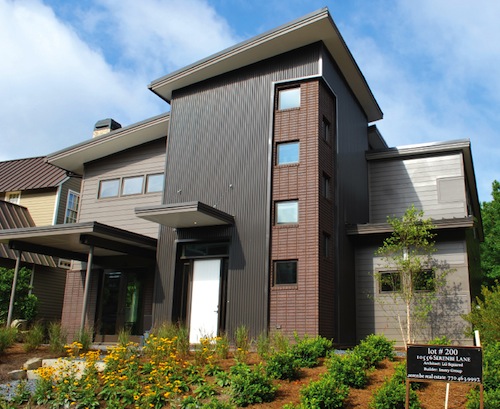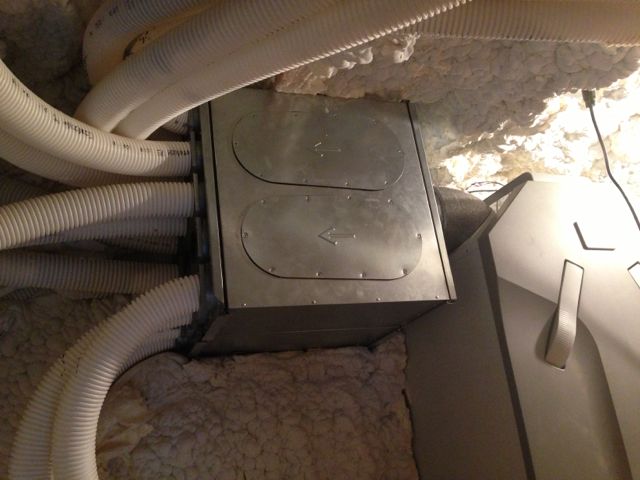A Net Zero Energy Home in a Beautiful Green Community

I spoke at Serenbe,† a beautiful green community southwest of Atlanta, this weekend and got a chance to visit a net zero energy home while there. Built by Luis Imery, one of the home energy raters we’re a HERS provider for, the home has garnered quite a bit of recognition. In fact, they recently picked up a pretty big award from Southface.
Before I get to that award, though, let me tell you a bit about the house. Net zero can be defined in different ways, and it also doesn’t have to mean the house itself is anything special. As Treehugger’s Lloyd Alter wrote sarcastically, “In Net Zero, you want to generate enough power on site to heat, cool and light your house; it could be a draughty barn, but if you put enough green gizmos on the roof to generate enough green energy to feed it, who cares?”
This house is not a draughty barn with lots of green gizmos. Luis paid attention to the details—and got them right. If you know your building science 101, you know that a high performance home has to do a good job of controlling the flows of heat, air, and moisture. In this home, they do that with Huber’s Zip R-Wall sheathing, Benjamin Obdyke’s rain screen materials, spray foam insulation, LG mini-split heat pumps, a Zehnder energy recovery ventilator, and more.
Luis is a smart home builder and put it all together in this great house. The house is airtight (less than 1 ACH50), has all the ductwork inside the building enclosure, insulated well (especially for climate zone 3), and has a mechanical ventilation system that distributes the air throughout the house (photo below).

You may recall that Building Science Corporation has a new ventilation standard out because ASHRAE’s standard (62.2) doesn’t give credit to to systems that distribute the air throughout the house. As you can see in the photo above, the Zehnder ERV has multiple ducts distributing air throughout the house, so the occupants will have fresh air everywhere.
The HERS Index for the home is -2. The reference point is 100, which means the home would just meet the 2004 energy code. ENERGY STAR V3 has a variable HERS Index target, which is usually in the 70s. This home, at -2, means that it’s modeled to produce more energy onsite than it uses during the course of a year. The 9 kilowatt photovoltaic system on the south-facing roof supplies the site-generated electricity.
There’s a lot more to the house than I’m fitting into this short article. The Proud Green Home website has an extensive list of design specifications.
The certifications they’ve picked up include ENERGY STAR Version 3, EarthCraft House Platinum, EPA Indoor AirPlus, and EPA WaterSense. It’s also the first Proud Green Home demonstration home. (PGH is a media company that promotes efficient and sustainable homes.)
The big award that Luis Imery picked up for the house was the EarthCraft House Project of the Year. Congratulations, Luis! Well done.
Allison Bailes of Atlanta, Georgia, is a speaker, writer, building science consultant, and the founder of Energy Vanguard. He has a PhD in physics and writes the Energy Vanguard Blog. He is also writing a book on building science. You can follow him on Twitter at @EnergyVanguard.
Related Articles
A Really Cool Net Zero Energy Home in the North Carolina Mountains
A 20 Year Old Energy Efficient House Goes to Net Zero in Florida
A Net Zero Energy Home in Rural Tennessee
Photo of front elevation of home from Serenbe real estate listings page.
Footnote
† Serenbe is the first place I took Martin Holladay earlier this year when he came to Atlanta. You can read about it in my article, The Energy Nerd’s Tour of Green Homes in Georgia. Alex Wilson also wrote about it because he’s been speaking in the same series at Serenbe, Bosch’s Green Living Seminars. His two articles are at Green Building Advisor: Energy-Saving Features of the Serenbe Community and Serenbe: a Green Town in the Making.
This Post Has 11 Comments
Comments are closed.

Nice list of features. What
Nice list of features. What are the numbers? HERS, etc., and how was bet zero achieved? Any “gizmos”? used like solar, wind, or perpetual power generators?
looks nice. Good work.
geoff h.:
geoff h.: I just added that info to the article. I meant to get it in there the first time, so thanks for the nudge. The HERS Index was -2, and I believe they installed a 9 kW PV system.
Allison- do you know if any
Allison- do you know if any of the performance has been measured on the ERV like static, flow, and power? Just curious.
That is a handsome place- nice work Luis!
The most amazing thing about
The most amazing thing about this home is that it is a spec! Money was available somewhere? And an appraisal supports the sale price? If so, that truly is amazing. If so, I would like details on that as much as on the gizmos that got it to negative two.
The “for sale” link has no mention of square footage, but at $700K I’m guessing it is at least 3,500.
Mike M.:
Mike M.: They got ENERGY STAR V3, so they had to commission the systems, including the ERV. I don’t know how it turned out.
Kim S.:
Kim S.: Yes, that is amazing. Luis has investors who put up the money, plus he did a good job of getting products and materials donated by manufacturers. I don’t know the actual square footage, but I’m pretty sure it’s closer to 2500 than 3500 sf, maybe even less.
These showcase projects are
These showcase projects are always inspiring. However, wouldn’t it be nice to see success in affordable scale developments and mass produced (tract) housing?
Theses showcases project the message that only expensive, large, and exclusive neighborhoods can achieve these levels of performance, and then only with vendor participation.
I would like to see a 1st time buyer community, or Habitat project, that achieves great performance at a price premium of maybe 2-3% to 5%, with reduced maintenance, energy, and insurance that offsets the premium.
Still, don’t mean to diminish achievement on this building, or hurdles overcome by all contractors and the Rater/Inspector/Verifier. Great work!
Hey there,
Hey there,
What are the flex tubes for. They are described as ducts. Is this a high velocity system?
Thank you
geoff h.:
geoff h.: I agree with you. I’ve written about Habitat here before and the great work they’re doing. Most recently, I wrote about a Habitat home in North Carolina that really impressed me. In addition, check out the three other net zero energy homes I’ve written about. They’re linked in the ‘Related Articles’ section at the bottom of this article. The objective of Matt & Amy in the first one, again in NC, was “to build for the same amount as everyone else.” After factoring in the incentives they received, their cost was $156 per square foot.
Conor R.: Yes, those are ducts for the ERV. Since it doesn’t move a lot of air (this one has a maximum rate of 215 cfm), it’s not going to have to move it very fast, so with the ducts you see above, it’s probably not going to be a high velocity system.
@Geoff, I agree (re: high
@Geoff, I agree (re: high prices for showcase homes). Just throwing money at a project isn’t very interesting. But one reason this particular home may cost so much is the steep lot prices at Serenbe. Before the crash, I understand some lots sold for well over $200k.
Hey Conor, those ducts are sold as accessories with the Zehnder ERV. I believe they’re made in Europe.
Net-Zero goal is good…but
Net-Zero goal is good…but is $300 per s.f. cost range the type home we should be touting?(after the world’s largest equity/housing melt-down) My upcoming simpler retirement home “Solar Wedge” with 1900sf of space (1536 main floor plus 380sf lofts) construction budget is less than $100 sf. By adding only 3000 watt PV (12 panels)it will be close to Net-Zero. (near-net) Folks…we need more modesty…which will beget more integrity for our industry.
$700K price tag examples are far up in the top 5% cost of American homes! We need real examples of practical Net-Zero that real people can relate too.